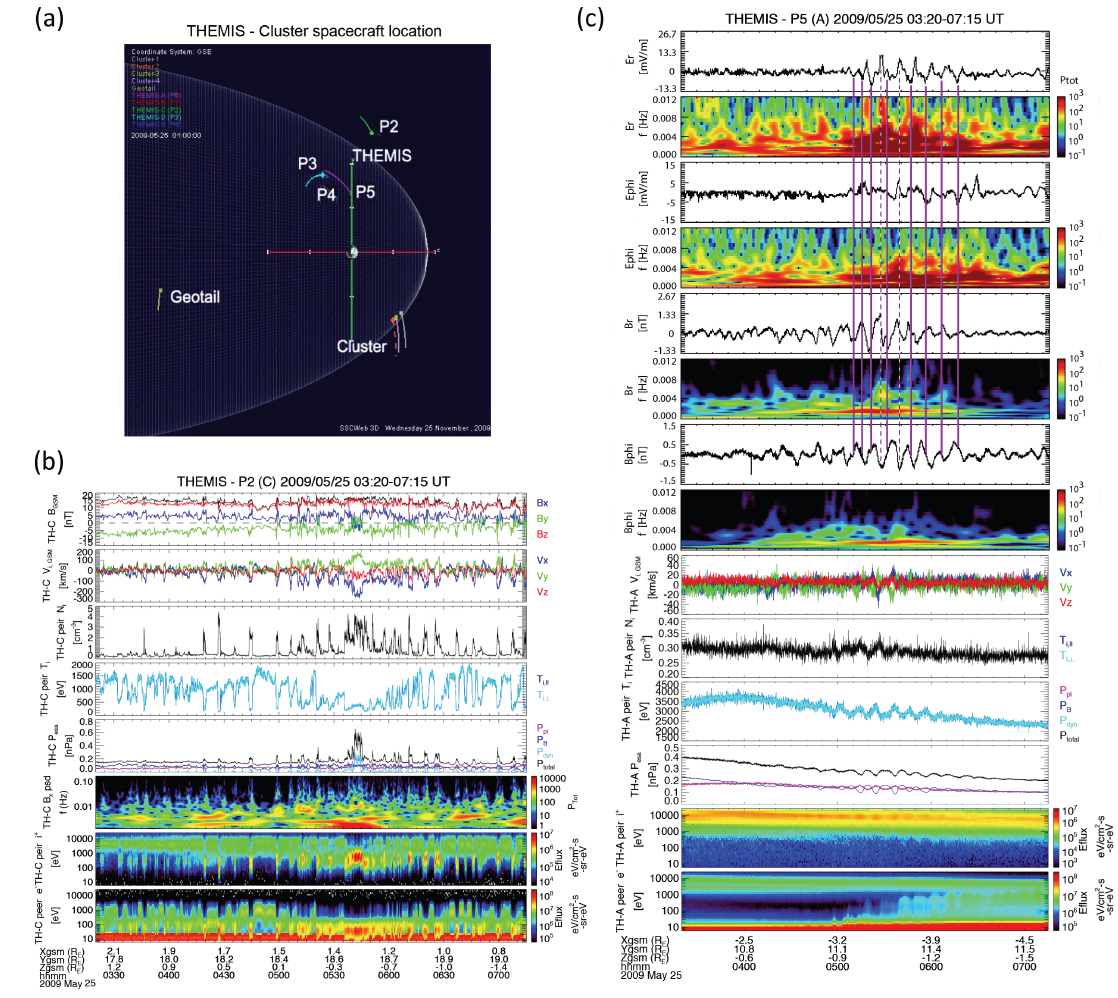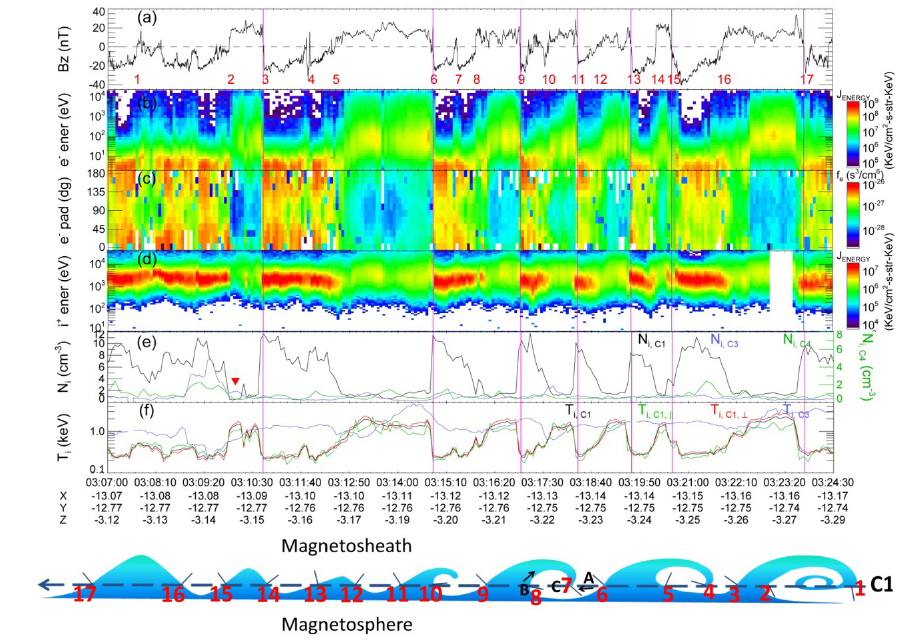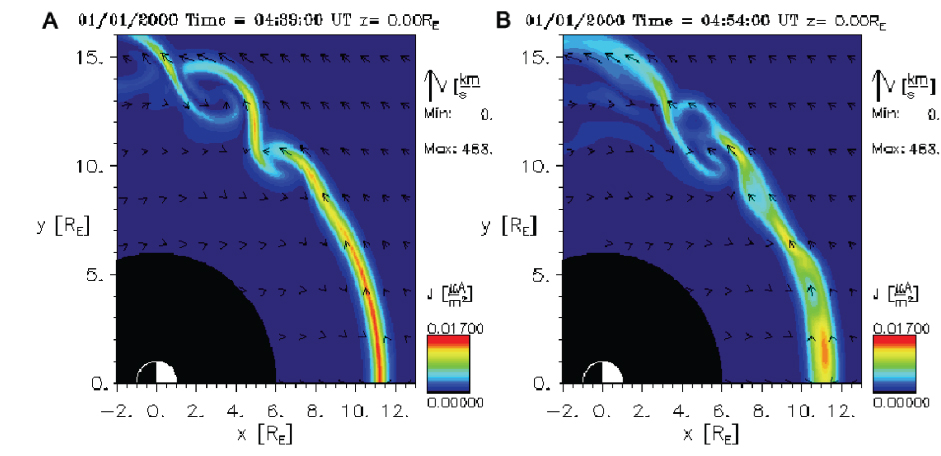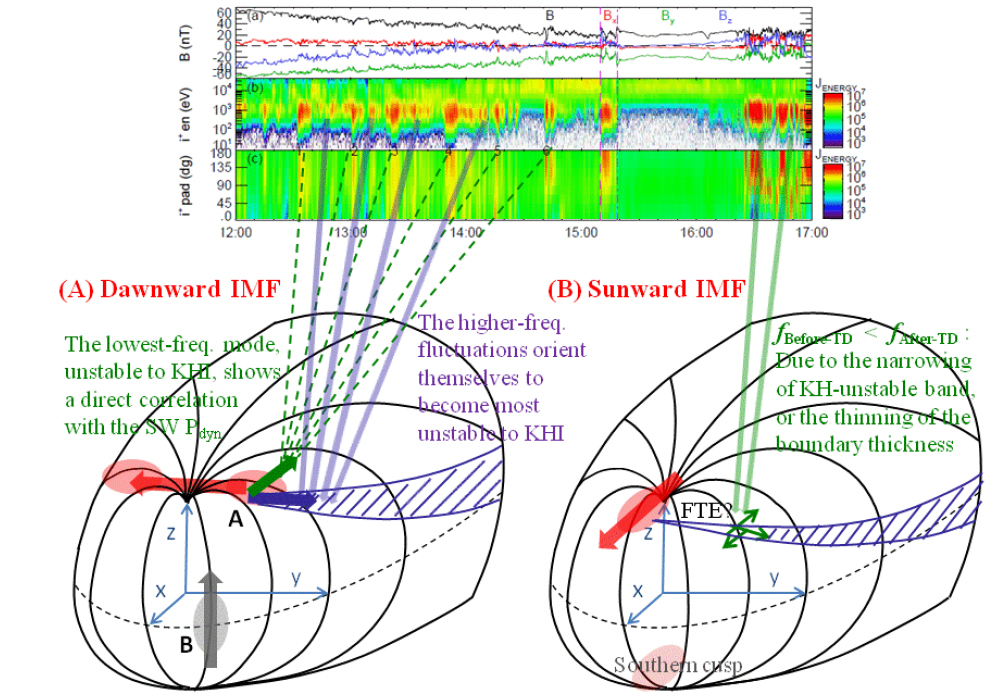



The solar wind carrying the interplanetary magnetic field (IMF) outward through the Solar System features a variety of temporal variations in plasma and field parameters and/or multi-scale structures. The magnetopause is the outer boundary of the Earth’s magnetic shield, being an interface between the time-varying solar wind and the relatively stagnant magnetosphere. Solar wind mass, momentum, and energy are, however, transferred across the magnetopause via magnetopause dynamics such as magnetic reconnection (e.g., Russell & Elphic 1978), kinetic Alfvén waves or ion gyro-radius scale waves (e.g., Chaston et al. 2007, Yao et al. 2011), or Kelvin-Helmholtz waves (e.g., Southwood 1968).
The importance of the magnetopause in the solar wind–magnetosphere coupling arises not only from its shape and location in response to interplanetary solar wind drivers, which, for example, leads to significant losses in the outer radiation belt electron fluxes to the magnetopause (e.g., Loto’aniu et al. 2010, Turner et al. 2012), but also more importantly from physical processes occurring at the magnetopause. Physical processes occurring at the magnetopause include magnetopause waves/oscillations and magnetic reconnection, which both provide multiple channels by which solar wind enters the magnetosphere, and inner magnetospheric particle populations can be enhanced or lost. In particular, Ultra-Low-Frequency (ULF; 1 mHz ≤ f ≤ 10 Hz) waves inside the magnetosphere are thought to be generated by the Kelvin-Helmholtz waves excited along the magnetopause and contribute to radial transport, losses, and enhancements of the radiation belt electron fluxes (e.g., Elkington et al. 2002, Loto’aniu et al. 2010). Dayside reconnection can drive outer and inner boundary motion and supply source populations to the radiation belts and ring current via storms and substorms. Flux transfer events (FTEs) generated by bursty or patchy reconnection drift along the magnetopause, exciting undulations of the magnetopause.
The dynamics of the magnetopause regulate magnetospheric responses to external interplanetary drivers (such as pressure pulses and quasi-periodic dynamic pressure perturbations) via frequency filtering of pristine solar wind or magnetosheath perturbations. In a steady state, the position of the magnetopause is determined by the balance between the total magnetosheath pressure, mostly contributed by the solar wind dynamic pressure, and the magnetospheric magnetic-field pressure (e.g., Aubry et al. 1971, Glassmeier et al. 2008). Various approaches to model magnetopause perturbations around the stagnation point (Smit 1968, Freeman et al. 1995, Børve et al. 2011) predicted damped harmonic oscillations for the magnetopause motion, having typical periods ranging from 2 to 12 min. This agrees well with in-situ observations of magnetopause fluctuations of periods of 3-5 to 10-15 min (e.g., Farrugia & Gratton 2011). The damping ratio and the transmissibility indicate that the magnetopause acts like a low-pass filter to suppress frequency modes that are much higher than the characteristic magnetopause and/or local field line resonance frequencies. Archer et al. (2013) demonstrated that impulsive and broadband magnetosheath pressure pulses are processed at the magnetopause into much smoother perturbations with longer periods (typically in the Pc5-6 range).
Recently, advanced multi-spacecraft, numerical simulations, and ground magnetometer/radar networks have enabled us to analyze the generation of magnetopause waves and their effects on the inner and outer magnetospheric dynamics. This paper reviews the role of the boundary waves in the dynamics of the magnetopause and the inner magnetosphere. In particular, Kelvin-Helmholtz waves and their nonlinear development into large-scale rolledup Kelvin-Helmholtz vortices have drawn increasing attention regarding their effects on solar wind entry across the magnetopause. This paper addresses theoretical and observational mechanisms responsible for the magnetopause waves triggering inner magnetospheric pulsations: cavity/waveguide/global modes (section 2); Kelvin-Helmholtz waves (section 3); and magnetic reconnection-driven processes (section 4). Conclusions follow in section 5.
2. CAVITY, GLOBAL, OR WAVEGUIDE MODES
Wave activity in the magnetosphere is often monochromatic and localized in latitude (Walker et al. 1979). In particular, ULF waves are typically observed on the ground in the Pc3-5 frequency range (Pc3: 22–100 mHz; Pc4: 45–150 mHz; Pc5: 2–7 mHz) at mid to high latitudes. Early studies (e.g., Stix 1962, Alfvén & Fälthammar 1963) reported that these wave modes have wavelengths comparable to the dimension of the magnetosphere cavity that is often bounded by the magnetopause and a turning point in the inner magnetosphere. Standing fast mode waves trapped between those magnetospheric boundaries are known as cavity modes or global modes (e.g., Kivelson & Southwood 1985). The boundaries are assumed to behave as perfect reflectors for waves, via strong gradients in physical quantities. Waves sustained in the magnetosphere cavity signify eigenfrequencies, which are determined by plasma conditions (e.g., the radial profile of the Alfvén speed) and the topology and the dimension of the cavity. Auroral HF-radar observations of discrete resonance frequencies at 1.3, 1.9, 2.3, 2.6, … mHz (Walker et al. 1992, Fenrich et al. 1995) are, however, too low to explain the wave cutoff location inside the magnetosphere. This has led to waveguide models where the energy of the fast mode waves that propagate azimuthally resonates radially between the magnetopause and a reflection region in the inner magnetosphere (Harrold & Samson 1992, Wright 1994).
The cavity/waveguide theory predicts that the mode traps energy of discrete-frequency fast waves between the outer and inner boundaries. The fast mode is thought to excite field line resonances (FLRs; standing shear Alfvén mode forming between perfectly reflecting ionospheres in the northern and southern hemispheres) at locations where the fast mode frequencies match the local Alfvén-wave frequency (Southwood 1974, Kivelson & Southwood 1985). When cavity modes excite FLRs, the Poynting flux should show an energy flow from the cavity mode into the FLR. Considering external sources that initially stimulate compressional modes, global modes behave like an intermediary that converts broadband solar-wind fluctuation energy to monochromatic, localized shear Alfvén waves (Hartinger et al. 2012). Energy transport from the magnetopause to deep within the magnetosphere (often inside the plasmasphere) is also explained in the context of “quasi-cavity” modes where wave energy leaks through the imperfect boundaries (Zhu & Kivelson 1989, Lee & Kim 1999).
The inner-magnetosphere ULF pulsations are well correlated with enhancements, radial transport, or modulation in low-energy and relativistic (> MeV) radiation belt electron fluxes (Elkington et al. 2002, Loto’aniu et al. 2010). ULF waves resonantly exchange energy with the particles when
Direct observational support for the excitation of the waveguide modes and the coupling of fast mode waves to FLRs is, however, somewhat sparse (Sarafopoulos 2005), although ground-based observations provide some statistical support for the cavity mode mechanism. While it was suggested that cavity modes may be an insignificant energy source for the FLR excitation (Allan et al. 1997), Richard & Wright (1995), using a 2-D MHD waveguide model, reproduced ULF pulsations detected by the DE 1 spacecraft, which traversed L shells ranging from
The ULF waves in the magnetosphere cavity can be excited by either internal or external sources. Internal sources include magnetospheric compressions that are internally driven associated with geomagnetic storms and substorms. External sources include magnetopause waves and quasi-periodic or impulsive variations in the solar wind. Early studies (McHenry et al. 1990, Mann et al. 1999, 2002) suggested magnetopause waves such as Kelvin-Helmholtz waves that are generated along the velocity-shear layer between the fast magnetosheath flow and the relatively stagnant plasma sheet as the dominant excitation mechanism for fast mode energy. The coupling to magnetospheric ULF pulsations occurs at locations where the local field-line shell eigenfrequency equals the frequency of the driving Kelvin-Helmholtz waves. Although it was suggested that the role of Kelvin-Helmholtz waves in the ULF excitation is limited (Takahashi et al. 1984, Southwood 1968), recent multi-point measurements indicated that the Kelvin-Helmholtz instability powers waveguide modes: Mann et al. (2002) reported Cluster observations of quasi-periodic magnetopause motion and simultaneous ground observations of ULF FLRs; Rae et al. (2005) used coordinated Cluster and Polar observations to link Kelvin-Helmholtz waves and FLRs. Agapitov et al. (2009) provided details of a THEMIS event supporting a toroidal FLR mode generated by the Kelvin-Helmholtz instability on the magnetopause.
Fig. 1 shows another example of a classical FLR excited by Kelvin-Helmholtz waves (Hwang et al. 2014). THEMIS-P2 traversing the dusk-side magnetopause observed surface waves identified by quasi-periodic fluctuations of the magnetic field and the plasma moments (density, flow vectors, and temperature) with a frequency of 1.9-2.0 mHz (Figs. 1a and b). The three inner THEMIS probes (P3-5) detected magnetic fluctuations peaked at a similar frequency of 1.8-1.9 mHz (Fig. 1c). These ULF pulsations are not directly correlated to the changes in solar wind dynamic pressure (not shown). The radial (
Since Dungey (1955) first proposed the importance of Kelvin-Helmholtz instability during northward IMF conditions, under which subsolar magnetic reconnection is suppressed, it has been suggested that Kelvin-Helmholtz waves provide a mechanism by which the solar wind enters into the magnetosphere. In particular, the nonlinear stage of Kelvin-Helmholtz instability, i.e., a rolled-up Kelvin-Helmholtz vortex, facilitates the solar wind transport via 1) diffusive transport through the turbulent decay of Kelvin-Helmholtz vortices or coalescence of neighboring vortices (Matsumoto & Hoshino 2004, 2006, Cowee et al. 2009), 2) reconnection between stretched field lines due to the vortex motion (Otto & Fairfield 2000, Nykyri & Otto 2001, Nakamura et al. 2011) and/or dual reconnection between the Kelvin-Helmholtz-stable lobe magnetic field and Kelvin-Helmholtz-induced engulfed magnetosheath field (Takagi et al. 2006), or 3) kinetic Alfvén waves or ion gyro-radius scale waves via a mode conversion from Kelvin-Helmholtz waves (Chaston et al. 2007, Yao et al. 2011). Kelvin-Helmholtz waves thus are one of the candidate mechanisms for the formation of a broad and dense low-latitude boundary layer (LLBL) as a consequence of a mixture of solar wind and magnetospheric origin plasmas.
The Kelvin-Helmholtz instability condition for incompressible plasmas under the assumption that the velocity-shear interface layer has no thickness (Chandrasekhar 1961, Hasegawa 1975), however, shows no clear preference for northward over southward IMF:
where v1,2,
Nonlinearly developed Kelvin-Helmholtz waves under southward IMF were reported by Hwang et al. (2011) (Fig. 2) and Yan et al. (2014). Hwang et al. (2011) proposed that a spatially-irregular and temporally-intermittent evolution of Kelvin-Helmholtz waves leaves little chance to observe Kelvin-Helmholtz vortex structures under southward IMF. This idea is supported by global MHD simulations (Collado-Vega et al. 2007, Hwang et al. 2011, Kuznetsova et al. 2008) demonstrating that under southward IMF Kelvin-Helmholtz vortices easily develop, but they quickly form as filamentary structures due to drifting flux ropes that originate at the subsolar magnetopause and disrupt previously formed vortices (Fig. 3). In contrast, Kelvin-Helmholtz waves/vortices during northward IMF are relatively stationary and long-lasting.
Recently, Hwang et al. (2012) reported the first in-situ observation of Kelvin-Helmholtz waves on the northern high-latitude magnetopause under strongly dawnward IMF conditions (Fig. 4). Under radial (sunward or anti-sunward) IMF, expansion of the dayside magnetopause and enhanced magnetopause fluctuations caused by bow-shock origin phenomena are common features (Duik et al. 2010, Omidi et al. 2009, Suvorova et al. 2010). The magnetopause expansion causes the magnetopause to become unstable to Rayleigh-Taylor instability, and the Kelvin-Helmholtz instability combined with Rayleigh-Taylor instability drives the entire dayside magnetopause to become Kelvin-Helmholtz-unstable (Farrugia et al. 1998). Gratton et al. (2012) and Farrugia et al. (2014) reported rolled-up Kelvin-Helmholtz vortices observed during a radial IMF. These studies indicate that Kelvin-Helmholtz waves are commonly observed over the entire surface of the dayside magnetopause for a wider range of IMF orientations than was previously thought, possibly providing a constant, although less efficient than reconnection, mechanism of solar wind transport into the magnetosphere.
4. MAGNETIC RECONNECTION OR FLUX TRANSFER EVENTS (FTES)-DRIVEN PROCESSES
Besides velocity-shear driven Kelvin-Helmholtz instability, other intrinsic instabilities operating at the magnetopause, such as current-driven instability, e.g., magnetic reconnection, can also provide seed perturbations for magnetopause motion. Magnetic reconnection on the dayside magnetopause controls the shape and location of the magnetopause, thereby modulating the properties of cavity/waveguide modes.
Non-steady bursty or intermittent reconnection, patchy reconnection, or sequential multiple X-line reconnection (Phan et al. 2004, Raeder 2006, Hasegawa et al. 2010) can generate recurrent flux transfer events (FTEs) with an average separation time of a few to several minutes (Wang et al. 2005). Russell & Elphic (1978) and Sckopke et al. (1983) noted that FTEs propagating along the downtail magnetopause produce magnetopause undulations similar to Kelvin-Helmholtz waves, possibly triggering the excitation of Kelvin-Helmholtz waves. Hasegawa et al. (2009) proposed that during northward IMF kinetic Alfvén waves that are excited through high-latitude reconnection and propagate toward lower latitudes cause perturbations in LLBL. These studies suggest a relationship between quasi-periodic reconnection at the subsolar (high-latitude) region under southward (northward) IMF and the quasi-periodic magnetopause perturbations. Such magnetopause perturbations, when their amplitudes are large, can launch compressional fast mode waves that traverse into the magnetosphere and excite inner magnetospheric ULF waves.
ULF waves themselves can regulate the dayside reconnection process. Prikryl et al. (1998) correlated the low-frequency (in Pc5 frequency range) oscillations with the IMF Bz component and convection patterns in the ionospheric footprints and suggested that ULF fluctuations in the solar wind modulate the rate of magnetic reconnection at the dayside magnetopause into pulses. Particle transit from the solar wind to the magnetosphere through magnetopause reconnection can facilitate ULF turbulence at the magnetopause (Cornilleau-Wehrlin et al. 2008). Lee et al. (2014) reported that the fluxes of cold ions present at the magnetopause are modulated by the ULF oscillations of E×B drift. The importance of such cold and dense populations in the reconnection process is a topic of ongoing debate (Cassak & Shay 2007, Borovsky et al. 2008, Drake et al. 2009, Lee et al. 2013). Hwang et al. (2014), using a THEMIS event, proposed that such cold ions of plasmaspheric plume or ionospheric outflow origin can play an important role in the competition between reconnection and Kelvin-Helmholtz instability during southward IMF, by reducing the reconnection rate but lowering the threshold of Kelvin-Helmholtz instability (Equation 1).
The Earth’s magnetopause provides diverse forms of free energy suitable for the growth of a variety of waves in association with kinetic-physics phenomena (such as magnetic reconnection in the dayside magnetopause and flux transfer events drifting along the downtail magnetopause) and velocity shear-driven or density/pressure gradient-driven MHD processes (e.g., Kelvin-Helmholtz or Rayleigh-Taylor instabilities). This paper reviewed those commonly observed magnetopause waves focusing on their generation mechanisms, links to the magnetospheric ULF pulsations, and effects on the outer (magnetopause) and inner magnetospheric system. The magnetopause waves play a significant role in the solar wind-magnetosphere coupling, while the magnetospheric ULF waves have a significant influence on mass, momentum, and energy transport within the magnetosphere. Pristine solar wind fluctuations and/or upstream bow shock phenomena that generate quasi-periodic or broadband impulsive perturbations downstream of the bow shock drive magnetopause motion and seed the magnetopause waves. The waves excite Aflvénic FLRs via coupling with magnetospheric modes that are well correlated with energization, transport, and losses of inner magnetospheric particles, for example, through the drift resonance. The magnetopause waves can, in turn, modulate the dynamics of the boundary layer, such as the development and evolution of Kelvin-Helmholtz waves/vortices and the efficiency of dayside reconnection.
Studies linking boundary waves occurring in the outer and inner regions suggest a need for further investigations to develop our understanding of how oscillations and wave energy generated at perturbed boundaries penetrate and evolve throughout the region between the boundaries and how they influence the magnetospheric responses to the external drivers. Coordinated multi-point analyses enabled by advanced multiple in-situ spacecraft and wide networks of ground-based measurements together with improved numerical models will address the coupling between surface waves and their effects on boundary-layer dynamics and Earth’s magnetosphere and ionosphere system, providing key information for space weather forecasts under a variety of interplanetary conditions and structures.




